Glazed in a homemade yakitori sauce, these Japanese Grilled Chicken and Scallion Skewers are hard to resist! You’ll love this simple Yakitori recipe with an easy savory-sweet sauce that you can make ahead. It’s great for grilling outdoors or under the broiler oven.
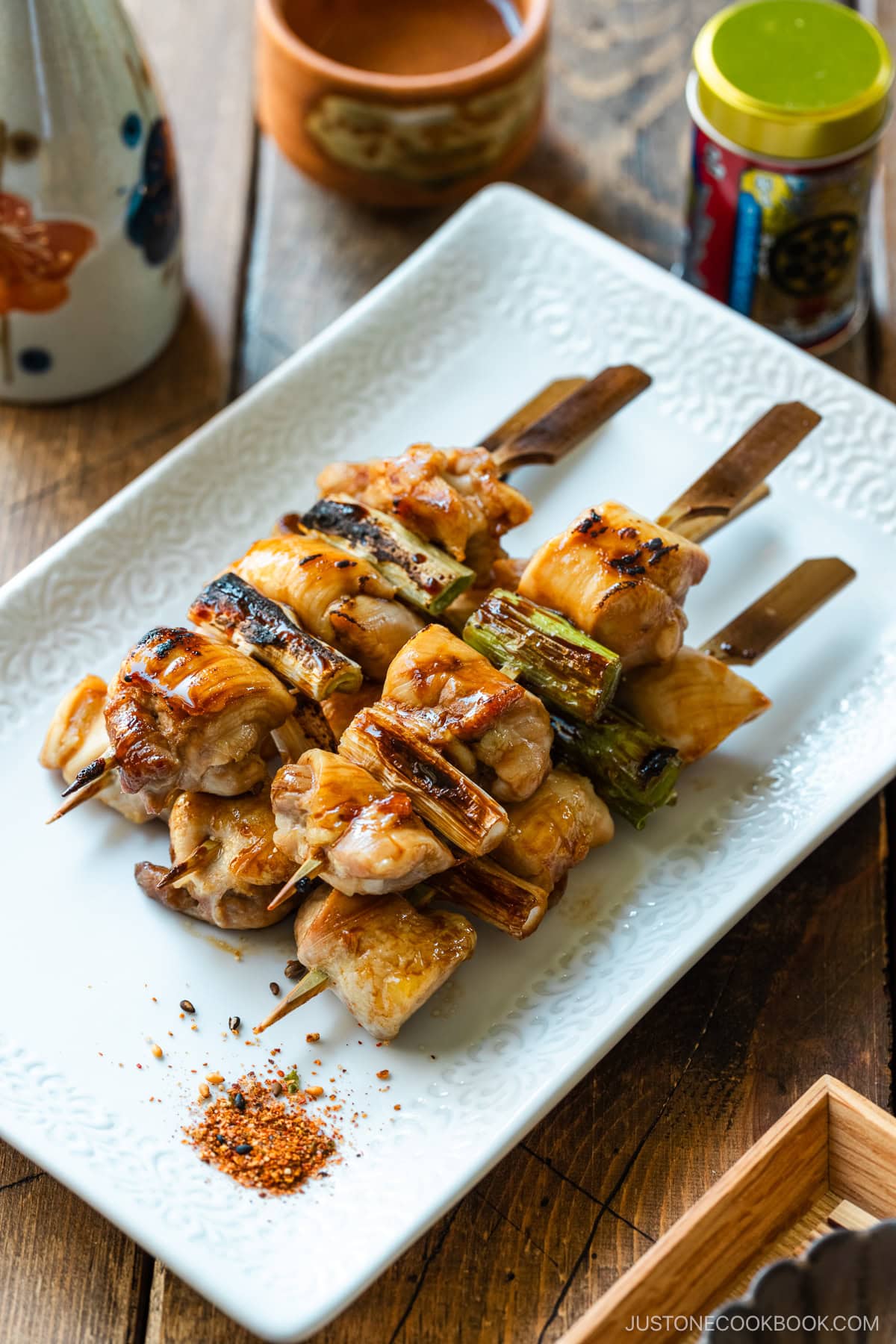
My family loves yakitori, and we we make sure to enjoy it whenever we visit Japan. It’s hard to resist the mouthwatering aroma of perfectly grilled chicken brushed with savory, caramelized yakitori sauce. The combination is simple yet sublime. I also have fond memories of meeting with friends over small plates of yakitori and drinks to catch up on work, family, and life.
Yakitori is such a fun and shareable food that’s nutritious, satisfying, and full of flavor. Best of all, it’s easy to make at home under your oven broiler with simple ingredients. Let me show you how with my Yakitori recipe!
Table of Contents
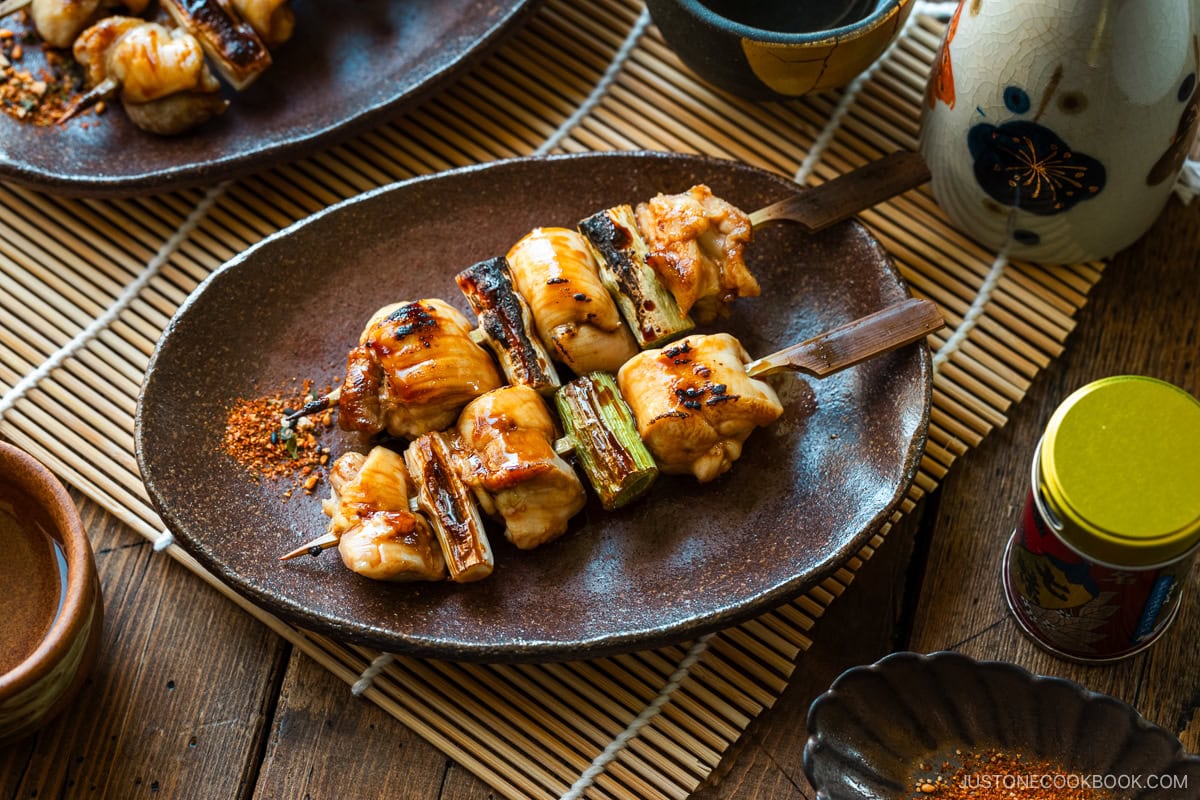
What is Yakitori?
Yakitori (焼き鳥) refers to Japanese-style grilled chicken skewers, literally translating to “grilled” (yaki) + “chicken” (tori). Traditionally, they’re cooked over hot Japanese binchotan charcoal on a long, rectangular grill that’s the perfect width to rest the bamboo skewers across the top.
The yakitori tradition uses every part of the chicken, from meat to organs to cartilage. Each chicken part has a distinct texture, flavor, and appeal. To bring out their best qualities, yakitori chefs employ various methods of butchering, skewering, seasoning, and grilling, while sourcing the best-quality chicken available.
Although skewered game birds or chicken have been part of Japanese cuisine for centuries, yakitori only gained popularity in the late 1950s with the introduction of broiler chickens bred for meat production by the United States. This led to an increase in the number of yakitori restaurants.
Today, yakitori can be found throughout Japan at single-item specialty restaurants known as yakitori-ya (焼き鳥屋). Shinjuku, Tokyo, boasts a famous street called Yakitori Alley with over 80 yakitori eateries! There’s even a street in Shinjuku, Tokyo, called Yakitori Alley with more than 80 yakitori eateries! Friends and colleagues often meet up at Japanese bars and pubs called izakaya (居酒屋) to snack on small plates of yakitori with a beer. They’re a popular menu item at festivals, and Japanese love to make yakitori on camping trips, too!
Why This Yakitori Recipe Works
You don’t need specialty equipment or unique chicken parts to make one of the most popular versions, called Negima Yakitori—grilled chicken thigh and scallion skewers. This recipe is easy, juicy, and full of flavor!
- Convenient oven broiling: Use your home oven‘s broiler to develop a nice char and grilled taste.
- Simple ingredients: My recipe uses boneless, skinless chicken thighs that you can find in any grocery store. They’re tender, juicy, tasty, and more forgiving to cook than chicken breasts.
- Easy homemade sauce: It takes just 4 pantry ingredients to make this traditional sweet-savory seasoning for an irresistible caramelized flavor.
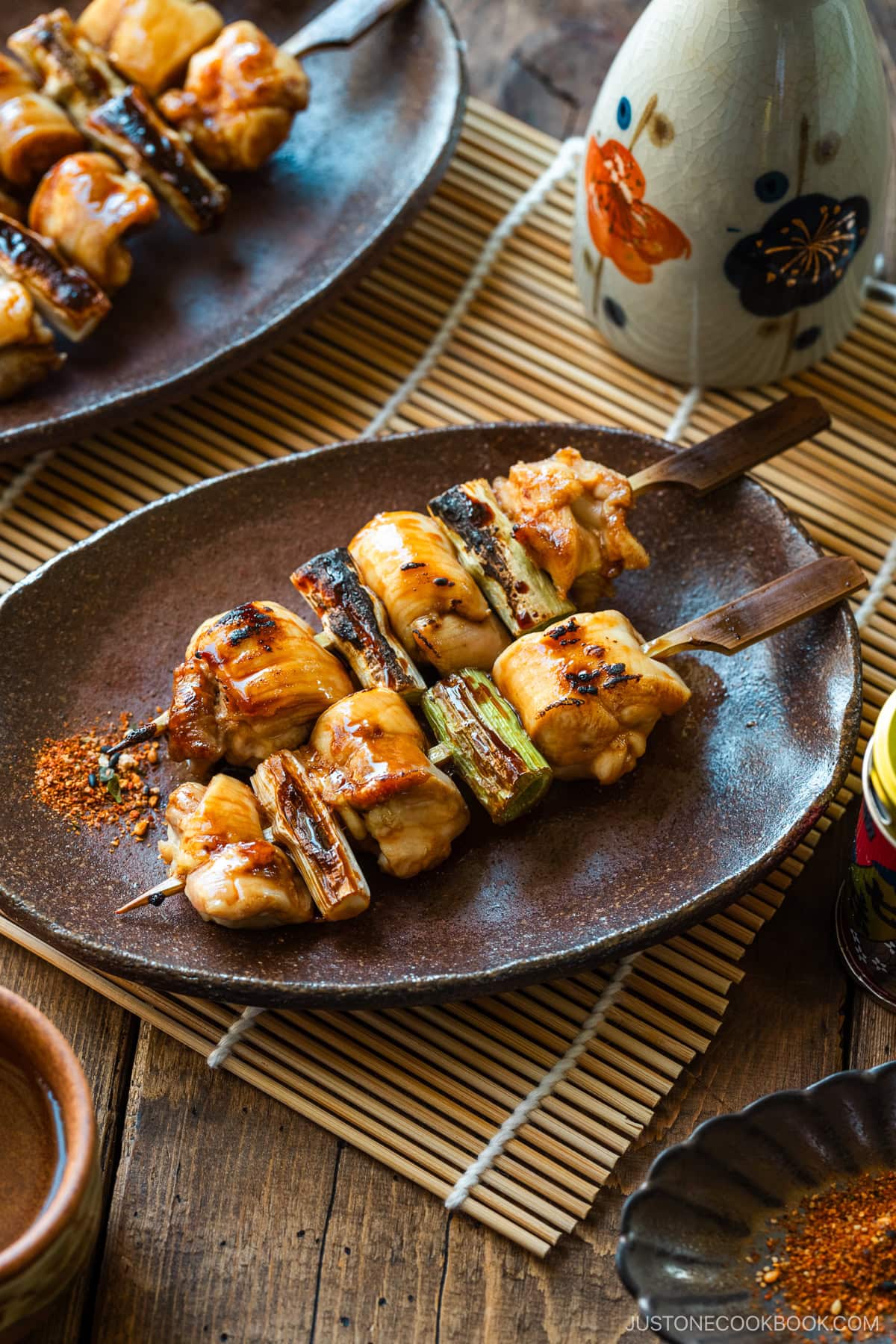
Ingredients for Yakitori and Yakitori Sauce
For this basic recipe, you only need a few ingredients. It’s easy to switch them up, and I’ve provided some substitution options in the next section.
- chicken thighs that are boneless and skinless; free-range, if you can find it
- Toyko negi or green onions
- sake, mirin, soy sauce, and brown sugar for the yakitori sauce (tare)
Substitution Tips and Variations
While my recipe is a classic version of yakitori, you can certainly use other ingredients:
- Chicken is traditional, but you could use other proteins like sliced beef, pork loin slices, or strips of pork belly. If you’re feeling adventurous, try other chicken parts—see below for ideas!
- Don’t miss out on trying yakitori with ground chicken meatball called Tsukune.
- Swap other vegetables for the Tokyo negi or green onion. Consider shiitake mushrooms, king oyster mushrooms, shishito peppers, cherry tomatoes, asparagus, zucchini, eggplant, and regular onions. You can even make plant-based Yakitori-style Grilled Vegetable Skewers for a vegan/vegetarian version.
- If you crave ginger and garlic flavors, try adding some to the saucepan before reducing the sauce.
- For a lighter seasoning, sprinkle salt (shio) on your skewers before cooking and skip the sauce (tare).
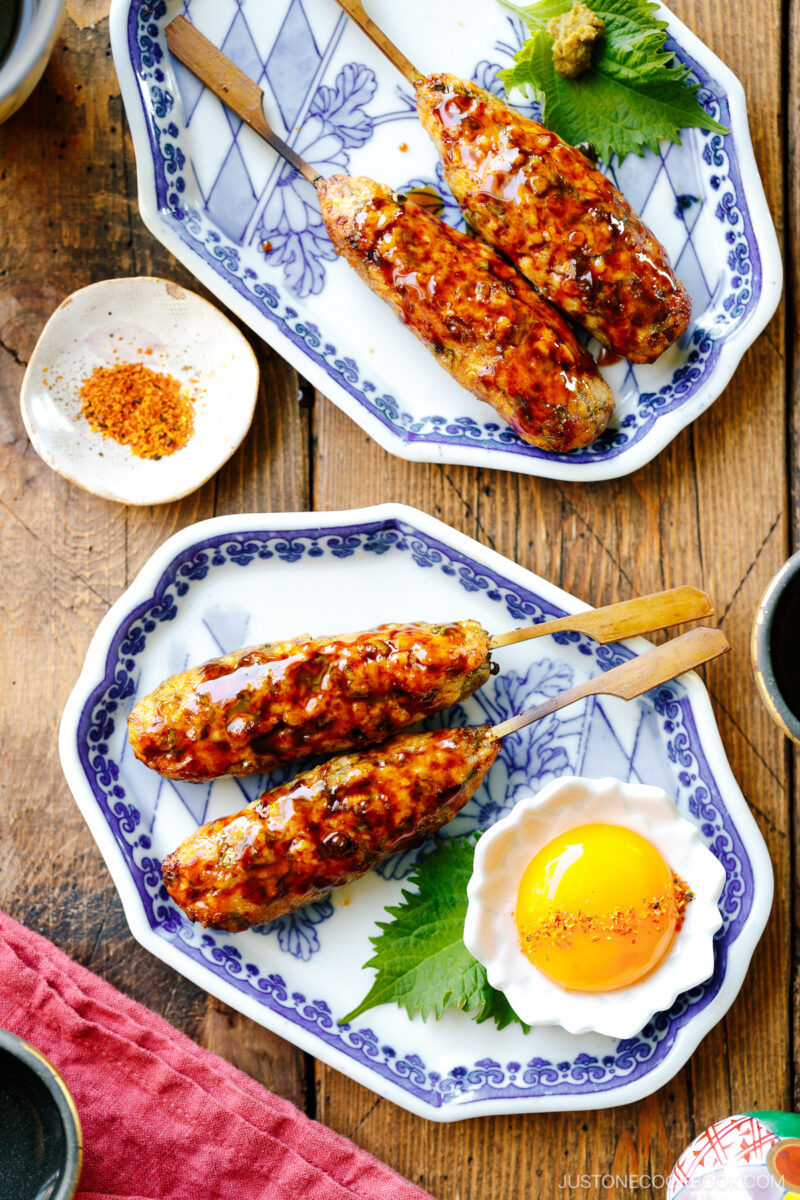
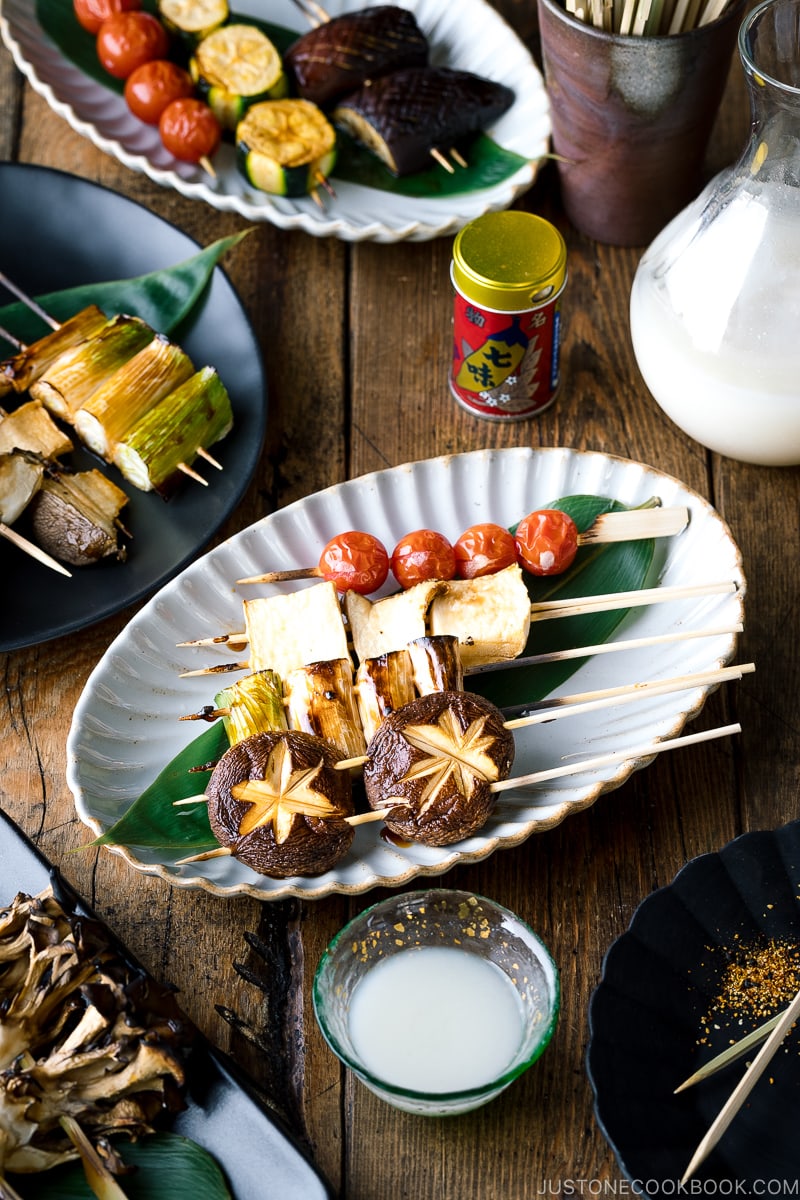
How to Make Yakitori
- Soak the bamboo skewers for 30 minutes. I use 5-inch bamboo teppogushi or “gun skewers” that have a flat tab for a handle. You can buy them at Japanese markets, on Amazon, or use regular bamboo skewers.
- Make the yakitori sauce.
- Thread the skewers with the pieces of chicken and Tokyo negi.
- Place the skewers on an oven-safe wire rack coated with oil or cooking spray and set it on a foil-lined baking sheet pan. Cover the handles with foil.
- Preheat the broiler to High, then broil the skewers for 6 minutes.
- Brush with the yakitori sauce, flip and brush the other side, then broil for 3–4 minutes to caramelize the sauce.
- Flip the skewers once more, brush them with the sauce, then broil for 1–2 minutes. Serve immediately.
How to Make the Best Yakitori Sauce
This traditional sauce (called tare in Japanese) is surprisingly simple, yet it’s all you need for an authentic yakitori flavor.
- Add the seasonings to a saucepan—soy sauce, mirin, sake, water, and brown sugar. Add the green parts of the Tokyo negi, too.
- Bring the mixture to a boil, then reduce the heat to low.
- Simmer and allow the sauce to reduce, uncovered, to one-third of its original volume (about 30 minutes).
- Let it cool to room temperature. The sauce is now ready to use.
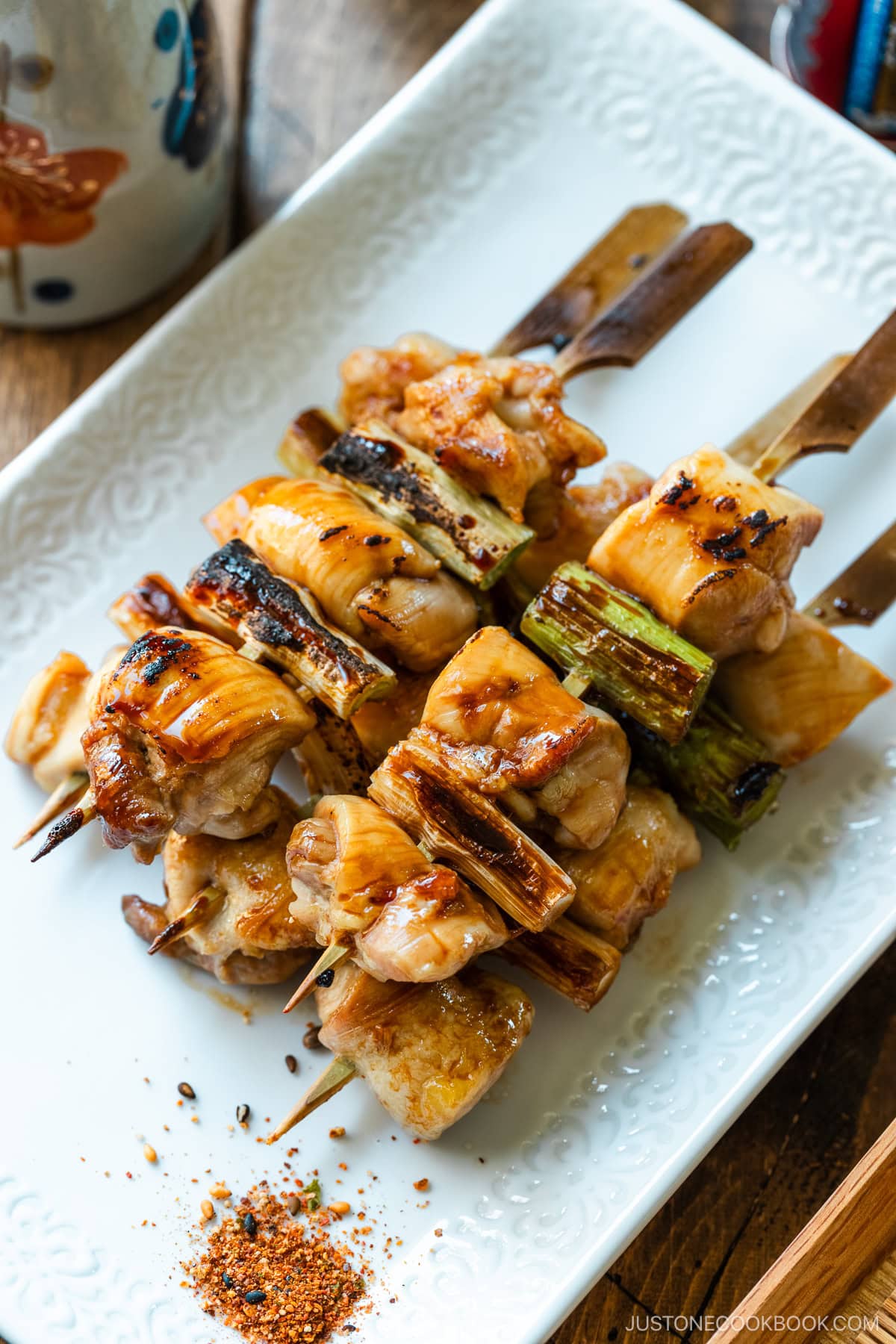
Skewering Tips and Techniques
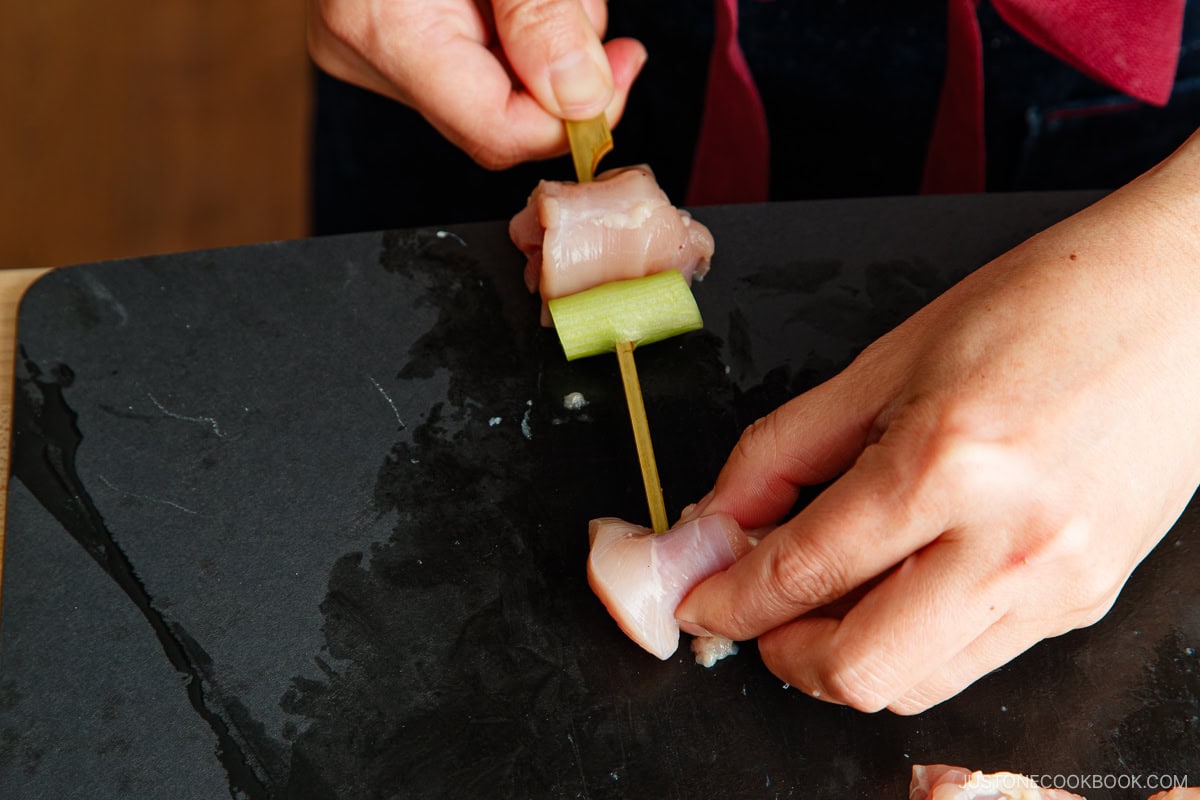
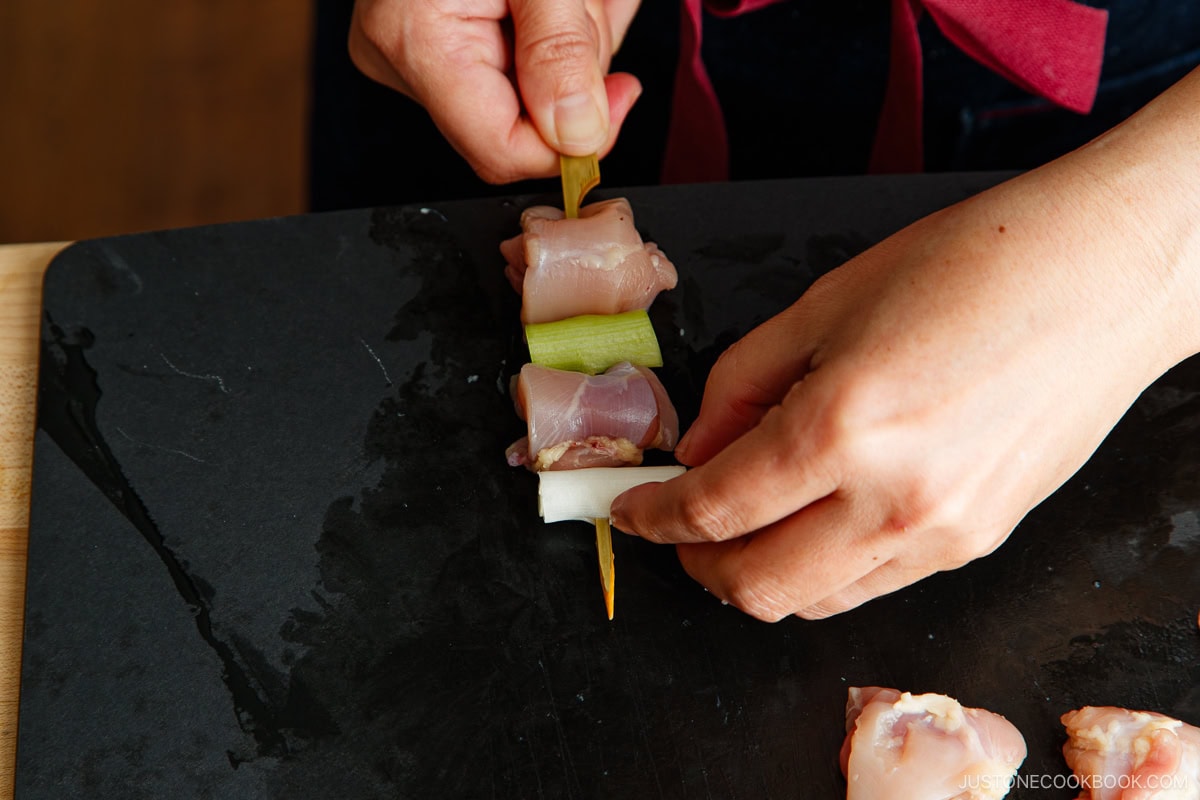
- On a flat work surface, fold a slice of chicken in half. Holding the skewer at a 45-degree angle, pierce the side of the folded meat. Then, tilt the skewer down so it‘s parallel to the work surface and push it all the way through. Position the chicken next to the handle.
- Add a piece of Tokyo negi perpendicular to the skewer, tucking it snuggly next to the chicken.
- Alternate chicken and Tokyo negi pieces, ending with a chicken slice.
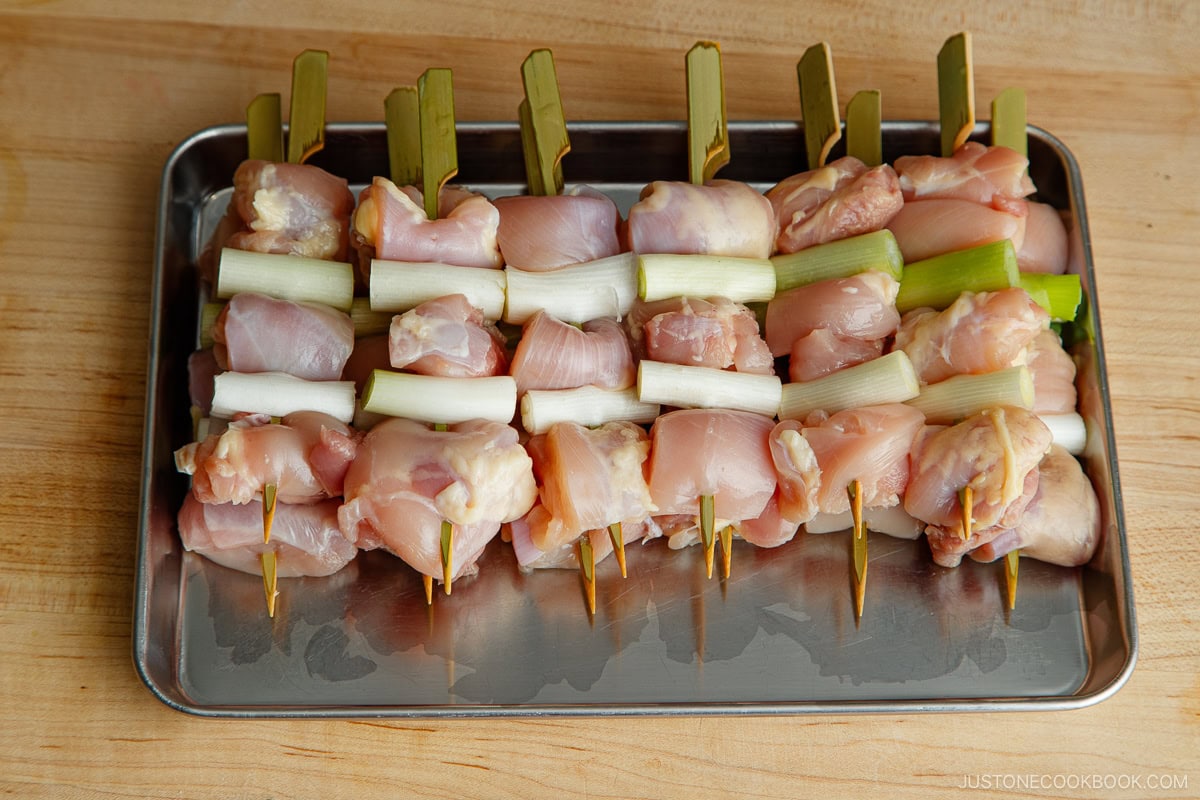
Other Chicken Parts for Yakitori
Here are some popular chicken parts that make delicious yakitori. How many have you tried?
- chicken thigh (momo, もも)
- chicken breast (mune, むね)
- chicken tender (sasami, ささみ)
- chicken skin (kawa, 皮)
- chicken wings (tebasaki, 手羽先)
- chicken tail (bonjiri, ぼんじり)
- chicken cartilage (nankotsu, 軟骨)
- chicken heart (hatsu, ハツ)
- chicken liver (rebā, レバー)
- chicken gizzard (sunagimo, 砂肝)
- ground chicken (tsukune, つくね) – Tsukune Recipe
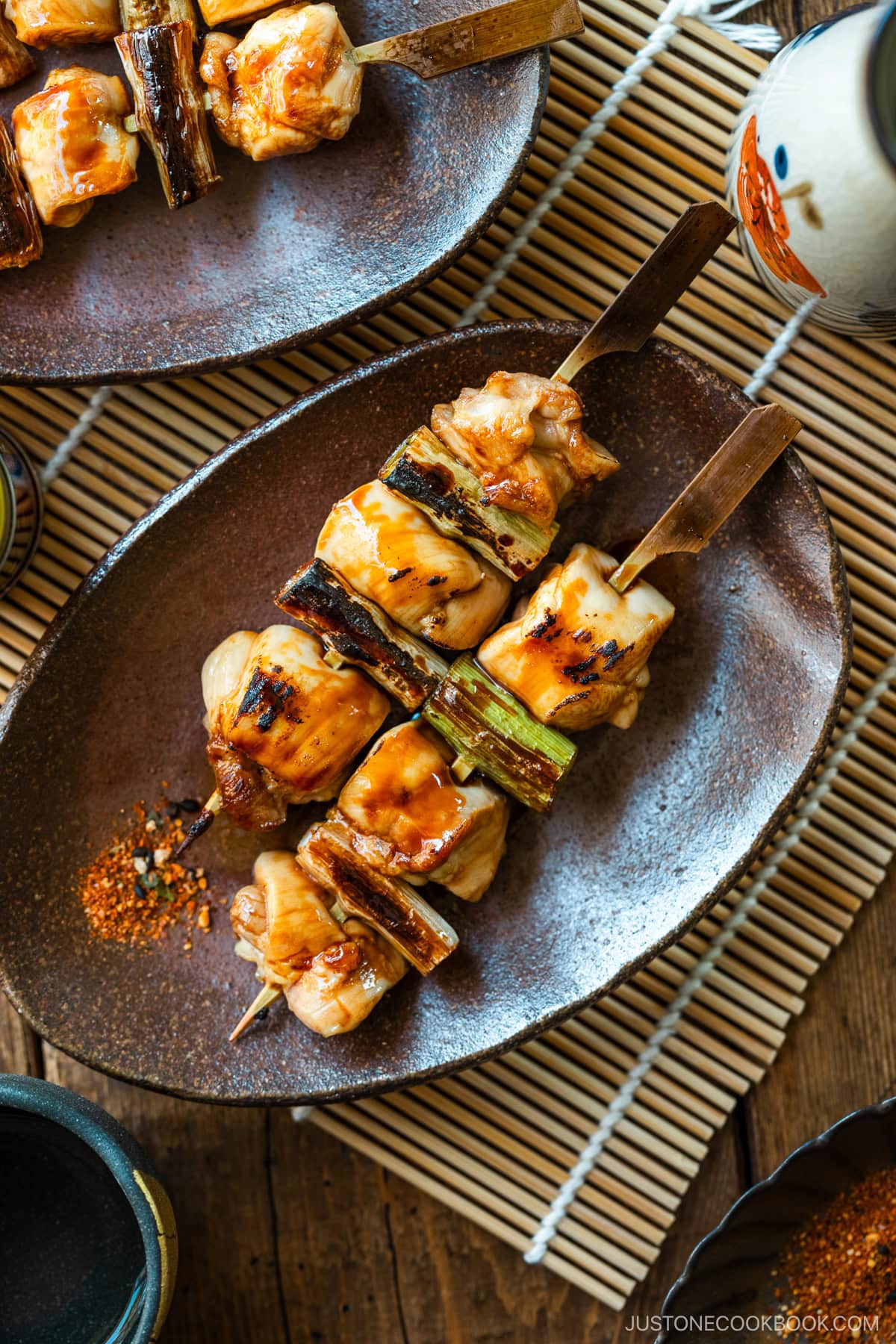
How to Store
- Leftover skewers: You can keep them in an airtight container and store in the refrigerator for up to 3 days or in the freezer for up to a month.
- Leftover sauce: Remove the negi greens from the sauce and pour it into a mason jar. Keep in the refrigerator for up to 2–3 months.
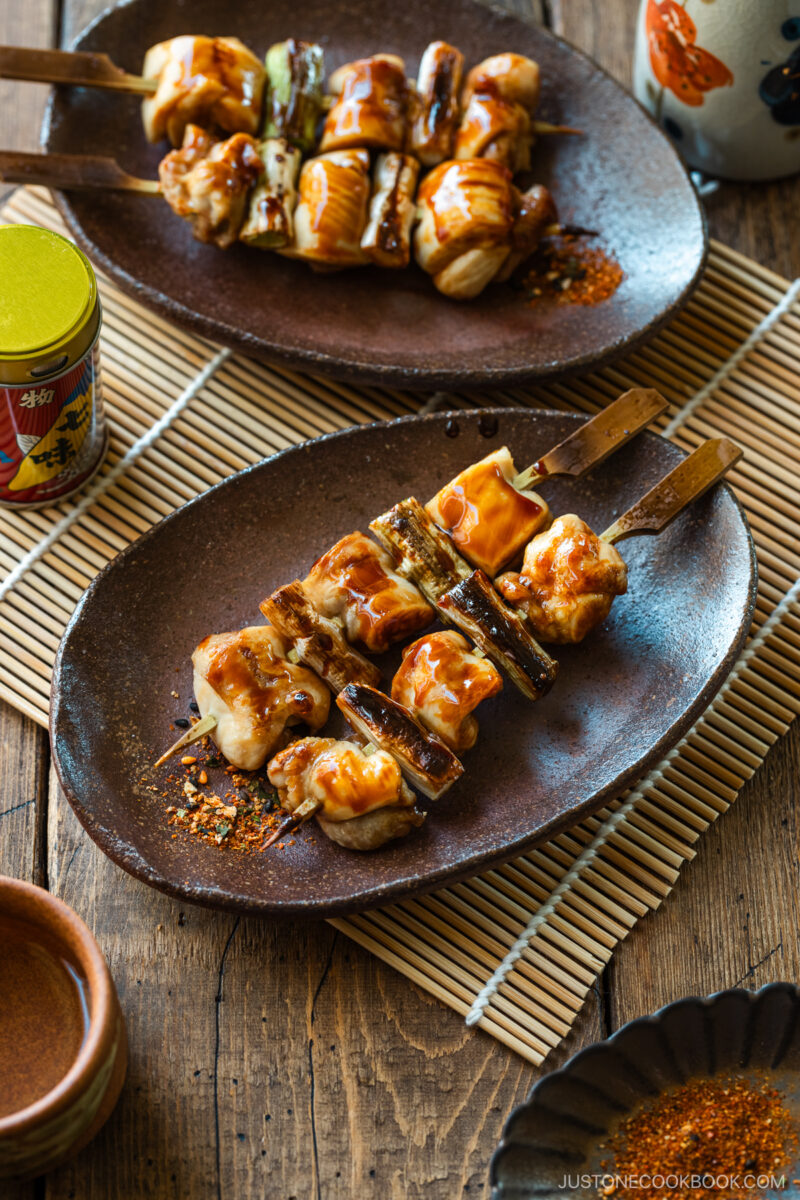
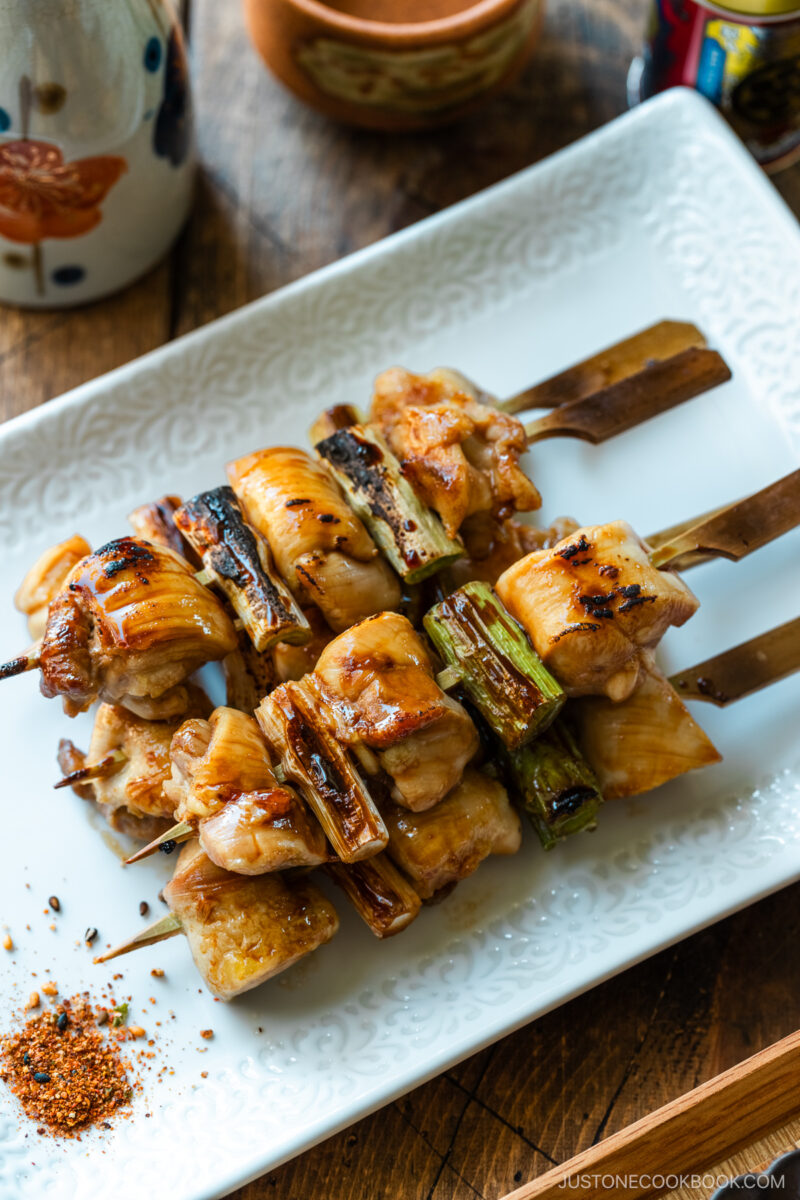
FAQs
Can I use chicken breast?
You can use chicken breast, though it tends to dry out easily. You’ll need to watch carefully while broiling. Keep in mind that breast meat is not as flavorful as thigh meat, so your skewers will have a milder taste.
Can I grill it outside?
Absolutely! In addition to the traditional yakitori grill, you can also use a hibachi BBQ grill or a standard outdoor BBQ grill.
What to Serve with Yakitori
- Rice – Yaki Onigiri, Miso Yaki Onigiri, Japanese Corn Rice
- Soup – Tomato and Tofu Miso Soup, Glass Noodle Soup, Cold Miso Soup (Hiyajiru)
- Salad – Japanese Cucumber Salad, Harusame Salad, Japanese Potato Salad
- Sides – Grilled Corn with Miso Butter, Edamame Pods, Blistered Shishito Peppers
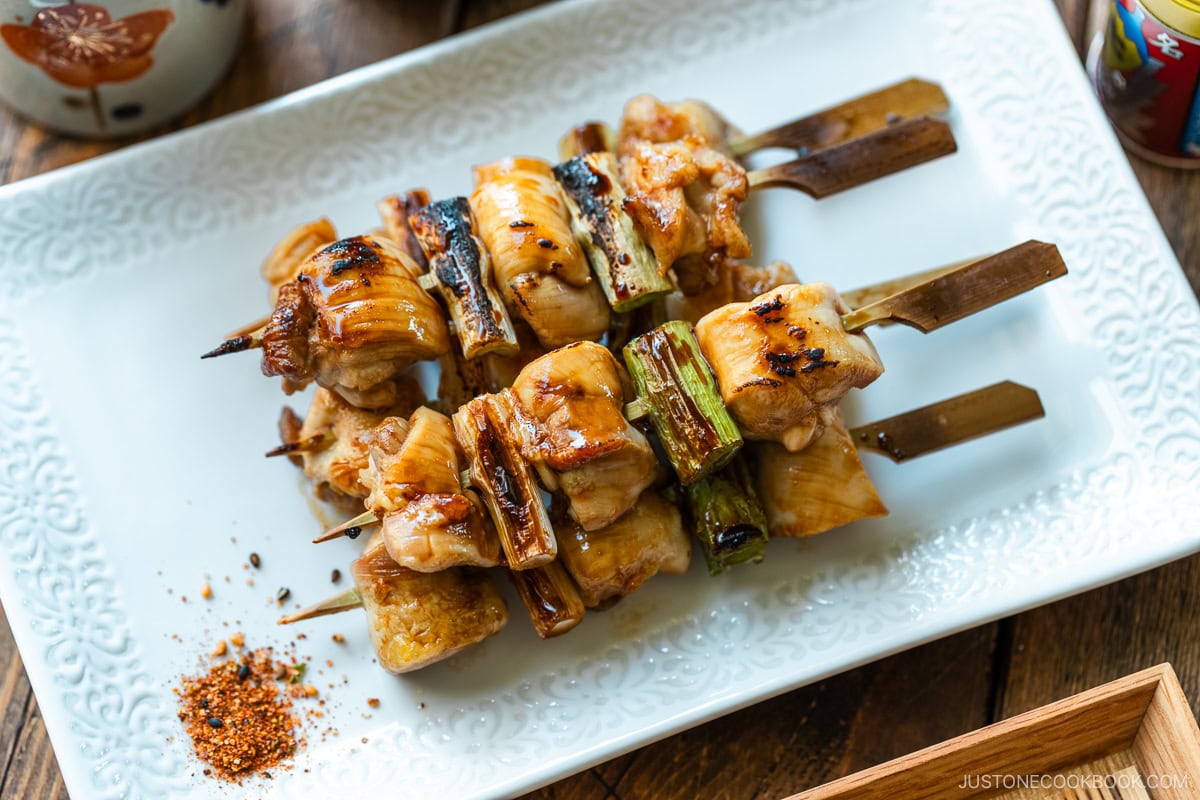
Wish to learn more about Japanese cooking? Sign up for our free newsletter to receive cooking tips & recipe updates! And stay in touch with me on Facebook, Pinterest, YouTube, and Instagram.
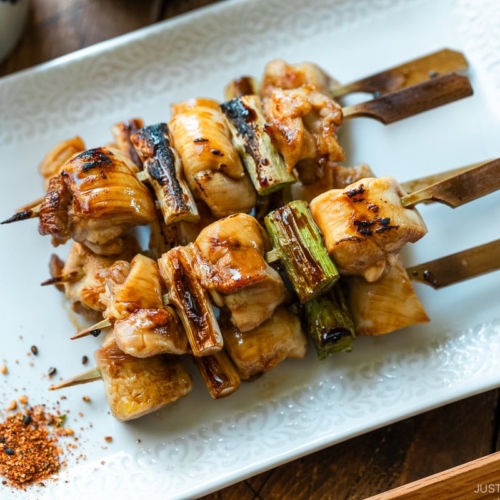
Yakitori Recipe with Homemade Sauce
Video
Ingredients
For the Yakitori Sauce (“Tare“):
For the Chicken Skewers
- 2 Tokyo negi (naga negi; long green onion) (or 9 green onions)
- 1 lb boneless, skinless chicken thighs (at room temperature)
- neutral oil (for brushing the wire rack)
- shichimi togarashi (Japanese seven spice) (optional; for a spicy kick)
Instructions
- Gather all the ingredients. For this recipe, I use teppogushi or “gun skewers” that have a flat tab for a handle. You can buy them at Japanese markets or on Amazon. If you can‘t find them, you can use regular bamboo skewers.

- Soak 10–12 5-inch bamboo skewers in water for 30 minutes.

- Separate the green part of 2 Tokyo negi (naga negi; long green onion) from the light green and white parts. Cut the white and light green parts into 1¼-inch (3-cm) pieces. Cut the green parts in half crosswise.

To Make the Yakitori Sauce (Tare)
- To a small saucepan, add ½ cup soy sauce, ½ cup mirin, ¼ cup sake, and ¼ cup water.

- Add 2 tsp brown sugar and the green part of the Tokyo negi.

- Bring it to a boil over high heat. Once boiling, reduce the heat to low and simmer, uncovered, until the sauce reduces to one-third of its original volume. It will take about 30 minutes. Let it cool to room temperature before using. The sauce will thicken with a glossy shine as it cools. Tip: You can make the sauce ahead of time. To store, remove the green onion from the sauce and pour into a mason jar. Keep in the refrigerator for up to 2–3 months.

- Tip: If you want to serve your yakitori with extra sauce, reserve one-third of the sauce in a small bowl for final basting, just before serving. To prevent cross-contamination, use this reserved sauce with a clean brush only after the chicken is fully cooked.
To Assemble the Skewers
- Cut 1 lb boneless, skinless chicken thighs into 1¼-inch (3-cm) squares.

- On a flat work surface, fold a slice of chicken in half. Holding the skewer at a 45-degree angle, pierce the side of the folded meat. Then, tilt the skewer down so it‘s parallel to the work surface and push it all the way through. Position the chicken next to the handle.

- Next, add a piece of Tokyo negi perpendicular to the skewer, packing it snuggly next to the chicken piece.

- Alternate skewering the chicken and Tokyo negi pieces.

- End with a piece of chicken. Each 5-inch skewer will hold about 3 chicken slices and 2 Tokyo negi pieces.

To Broil/Grill the Yakitori (recommended)
- Line a baking sheet with aluminum foil for easy cleanup. Place an oven-safe wire rack on top. Grease the grate of the wire rack with neutral oil to keep the chicken from sticking.

- Place the skewers on top in two rows, with the handles resting along the edges of the baking sheet. Cover the top and bottom of the handles with folded strips of aluminum foil to prevent burning.

- Preheat the broiler to High and wait until the heating elements are hot, about 3–5 minutes. Then, place the skewers under the broiler. Broil for 6 minutes.

- After 6 minutes, brush the meat and Tokyo negi with the yakitori sauce.

- Flip the skewers carefully with a pair of tongs. Brush on the other side with the yakitori sauce. Continue to broil for 3–4 minutes to caramelize the sauce.

- Finally, flip one more time (this is the presentation side). Brush with the yakitori sauce and broil for 1–2 minutes. Remove the baking sheet from the oven.

To Pan-Fry the Yakitori (optional)
- Heat a large frying pan on medium heat. When it‘s hot, add about 1 Tbsp neutral oil. When the oil is hot, place the skewers in the pan in a single layer (you may have to cook in batches). Cook until both sides are brown, about 5 minutes each side. Then, cover and cook on low heat for 2–3 minutes. Add the sauce to the pan and cook until well coated. Remove from the heat.
To Serve
- Transfer the skewers to a serving plate, presentation side up. Optionally, with a clean brush, baste the top of the chicken skewers with the reserved sauce. Serve with shichimi togarashi (Japanese seven spice) and enjoy!

To Store
- You can keep the leftovers in an airtight container and store in the refrigerator for up to 3 days or in the freezer for up to a month.
Nutrition
Editor’s Note: This post was originally published on Apr 13, 2014. It was updated with new step-by-step and final images on April 18, 2024.
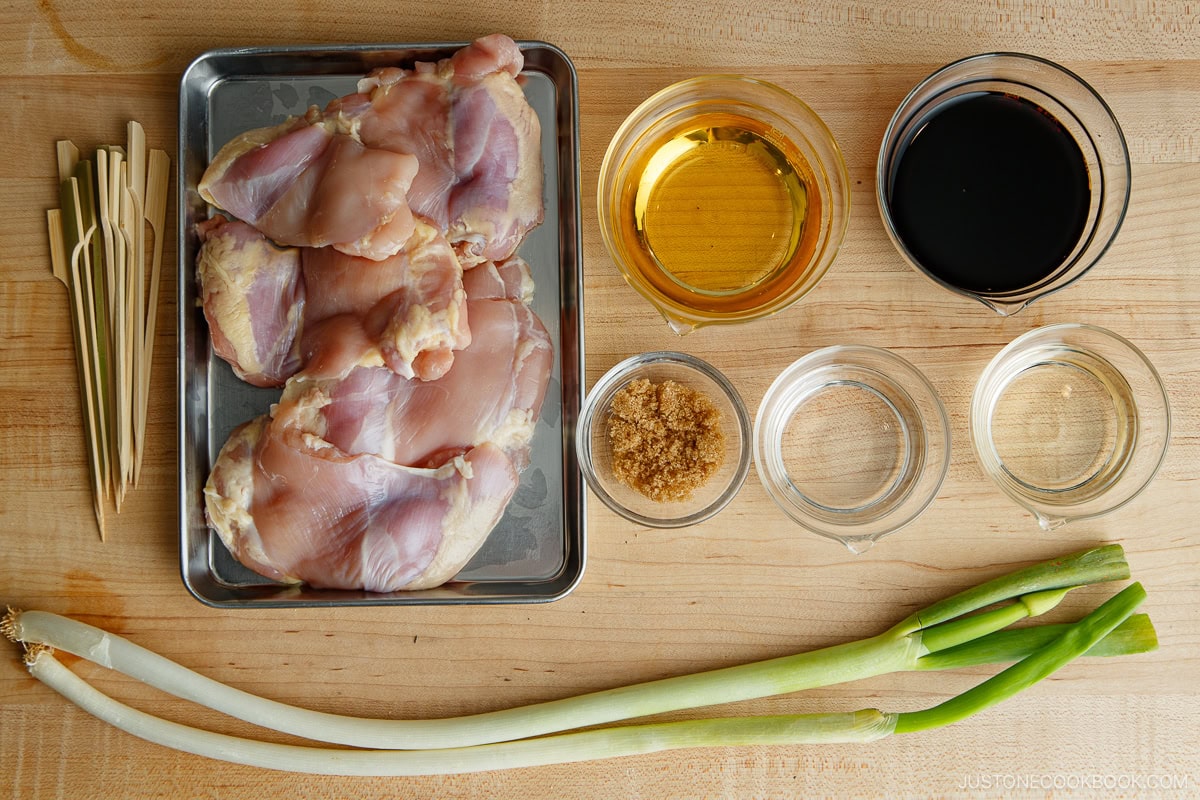
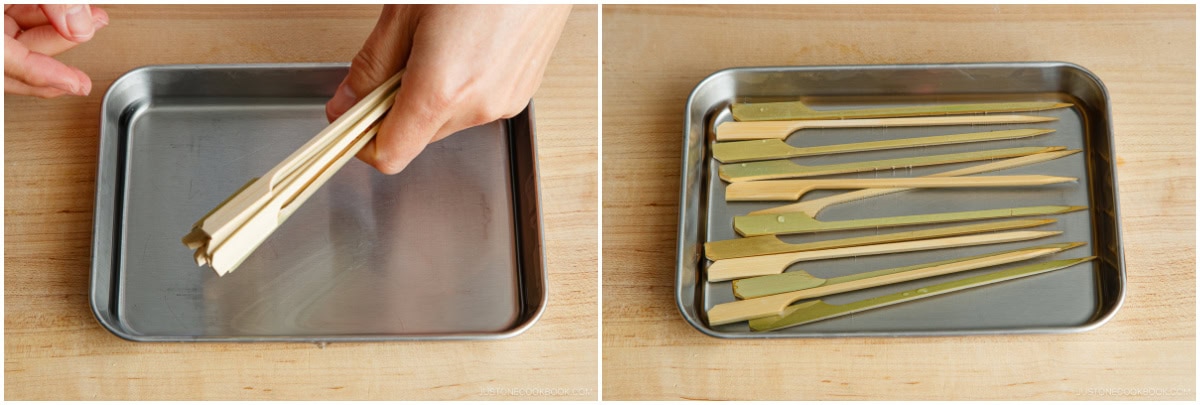
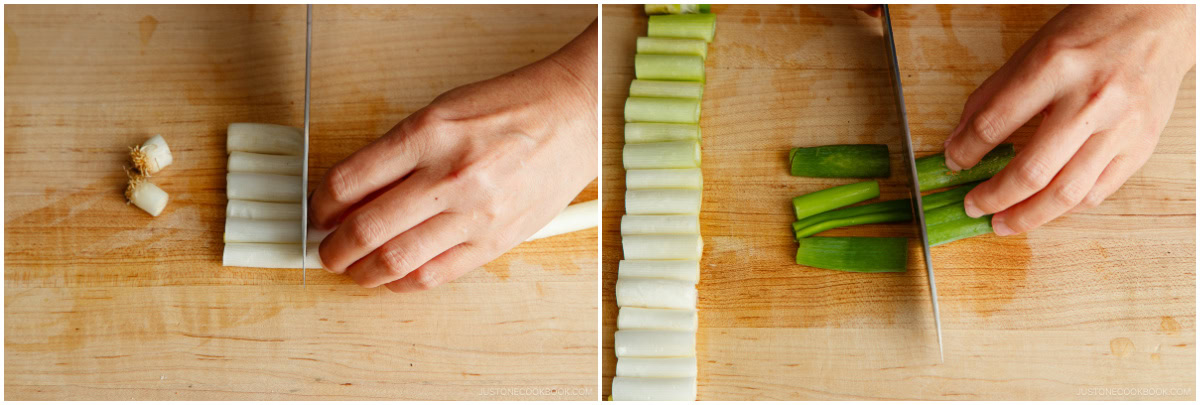
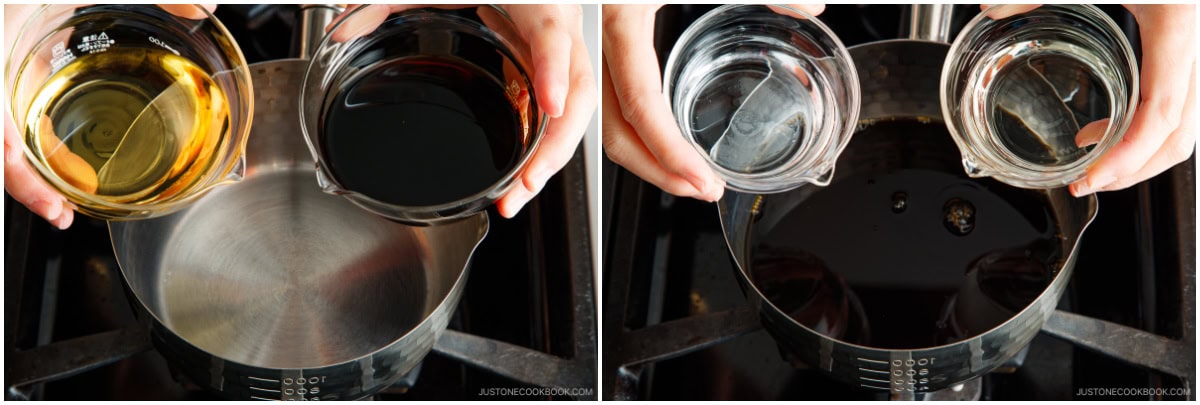
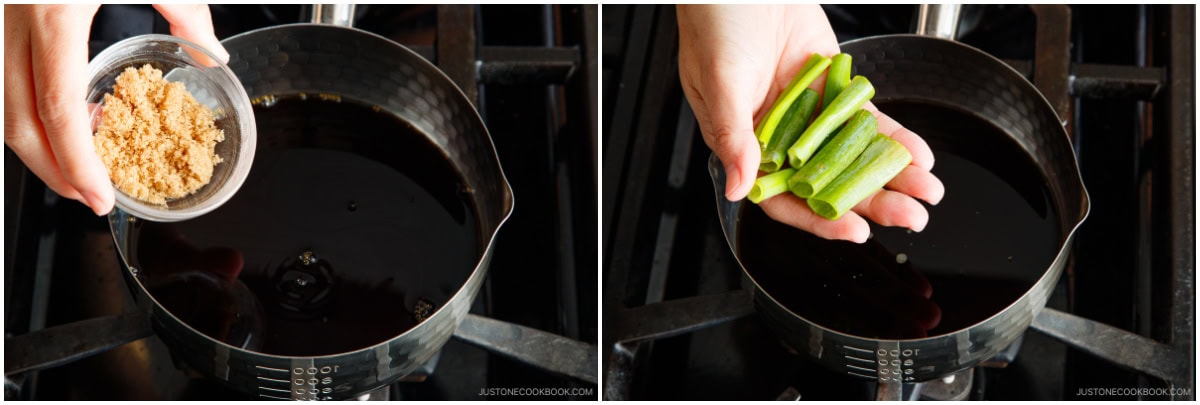
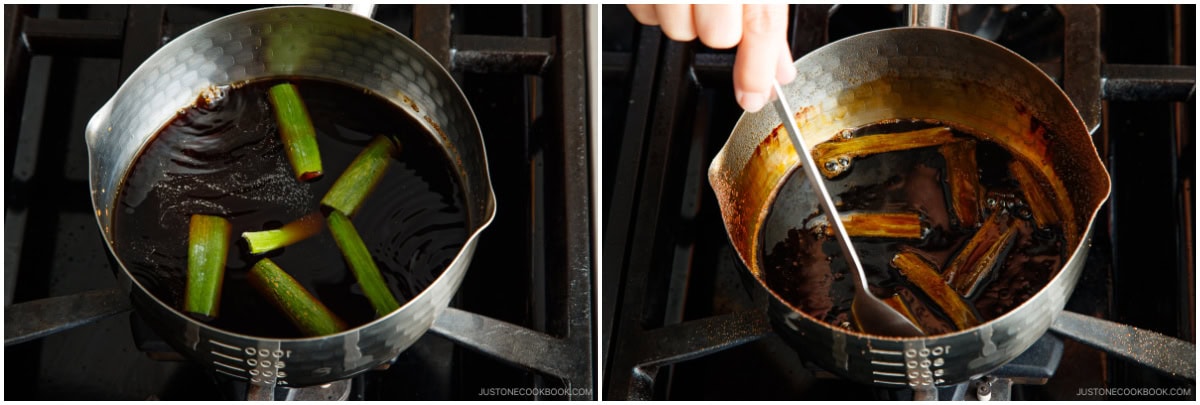
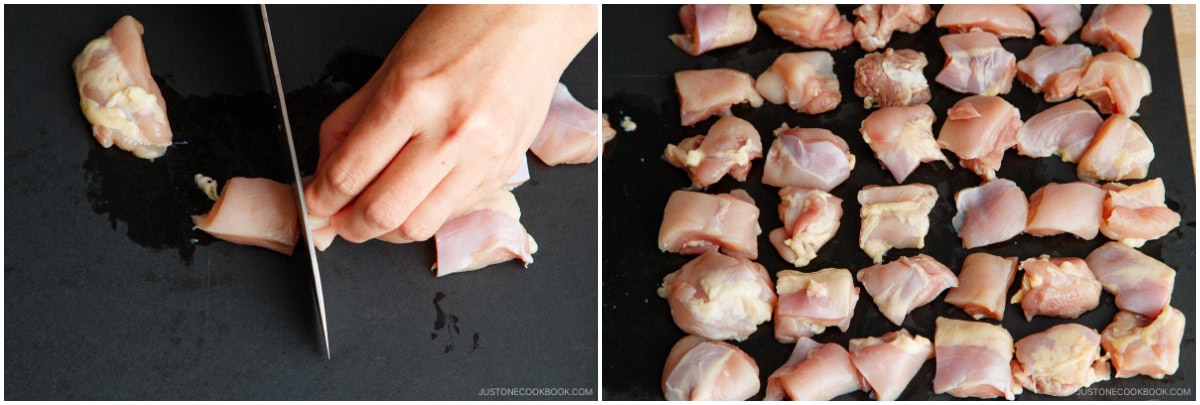
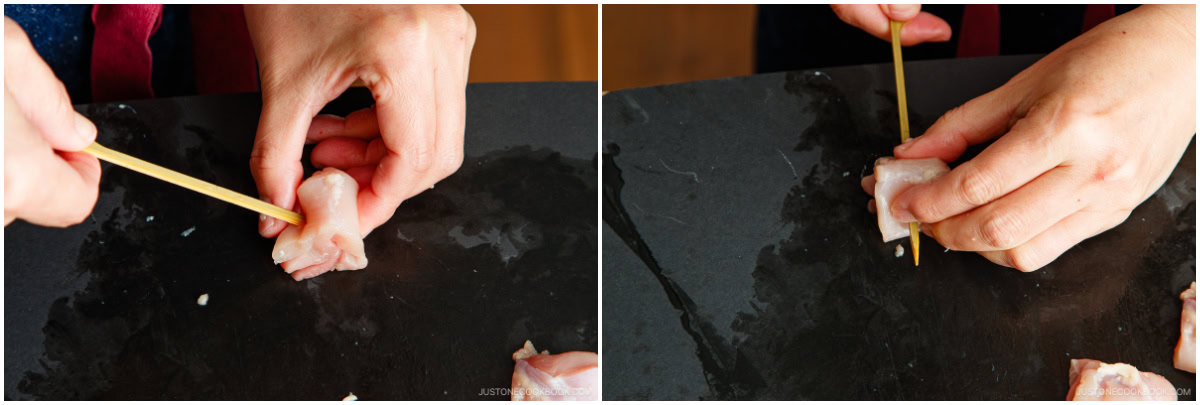
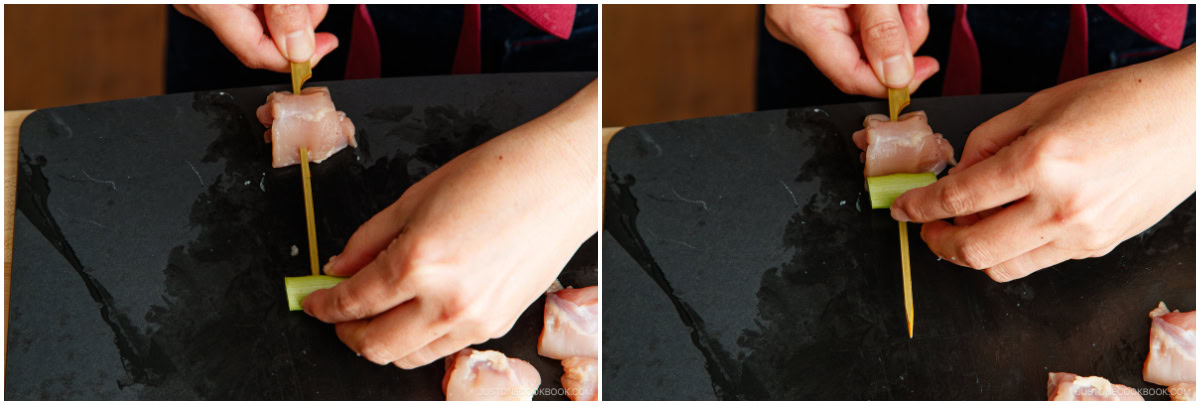
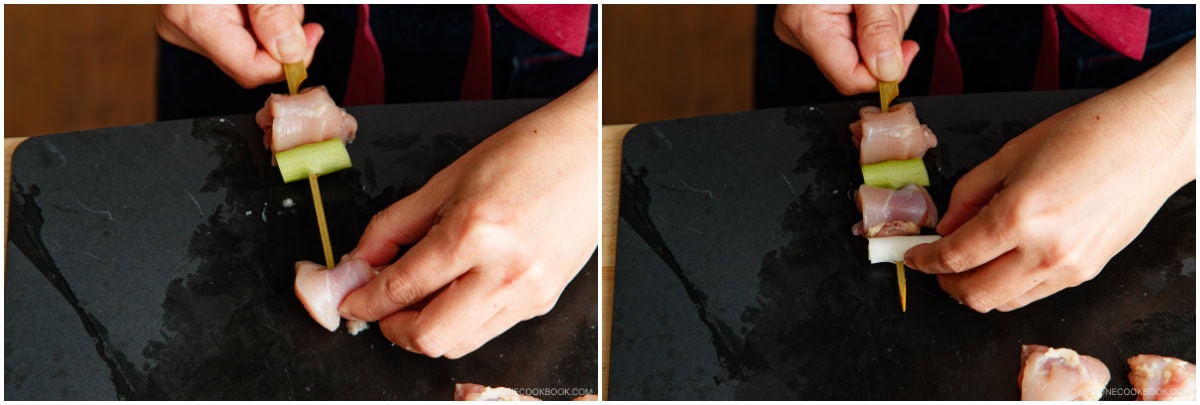
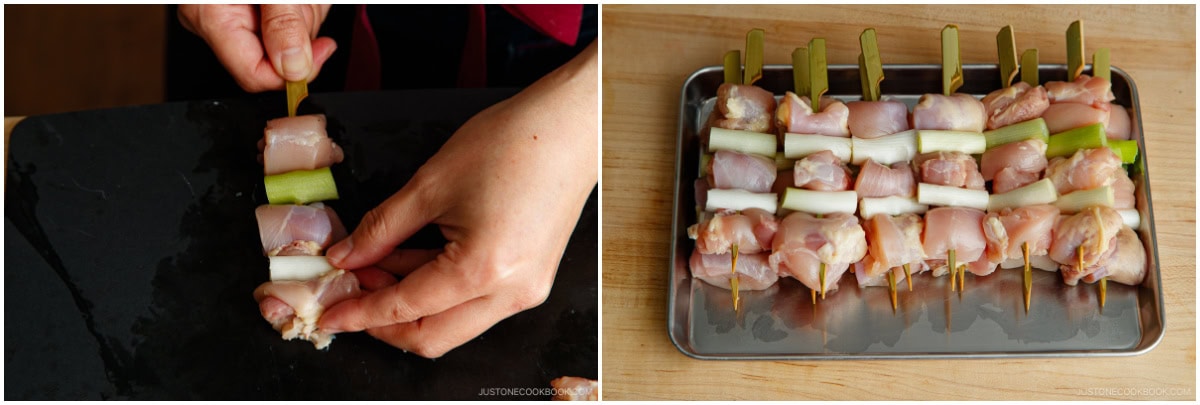
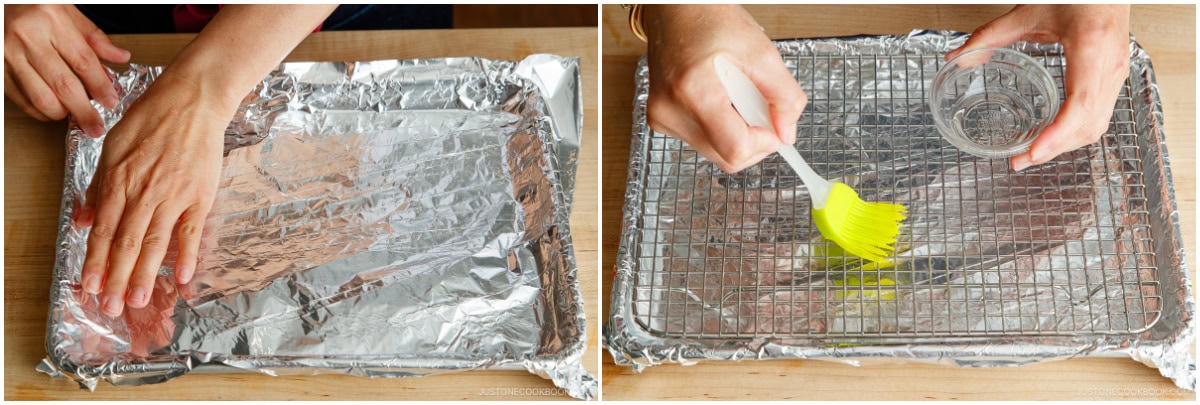
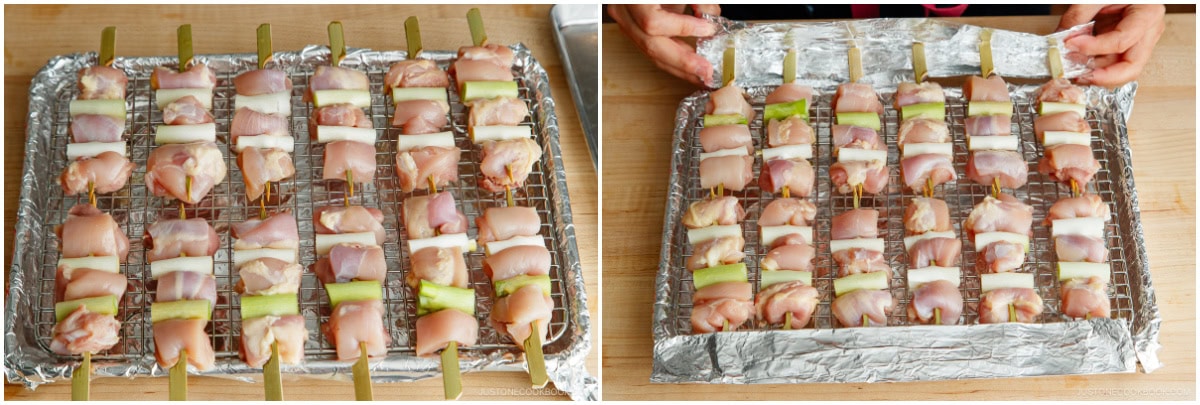
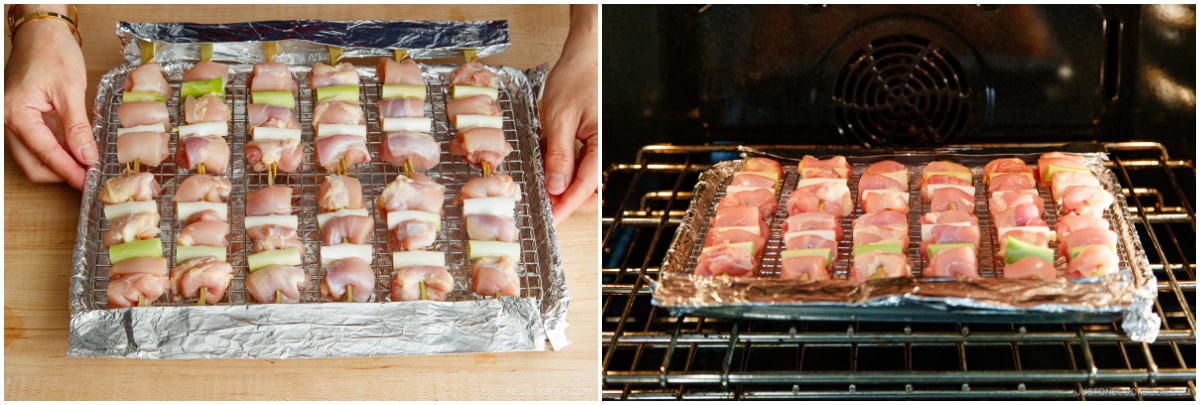
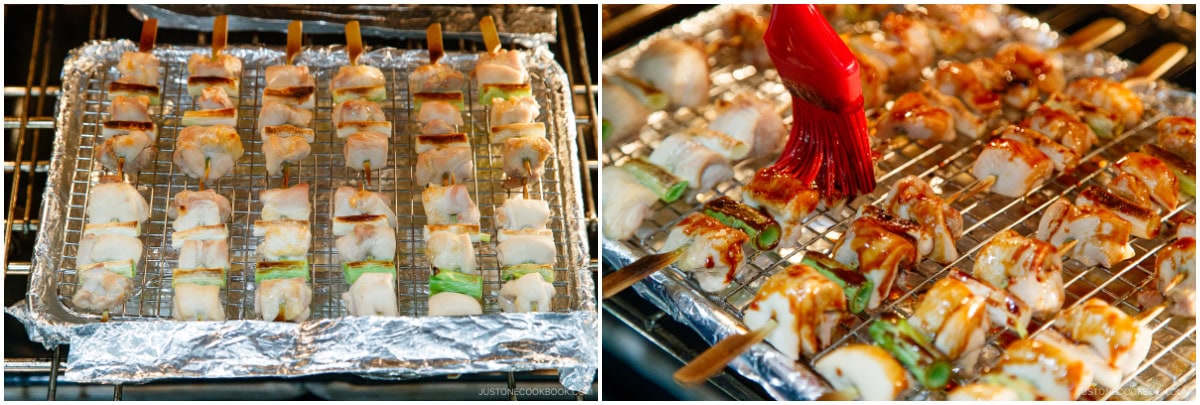
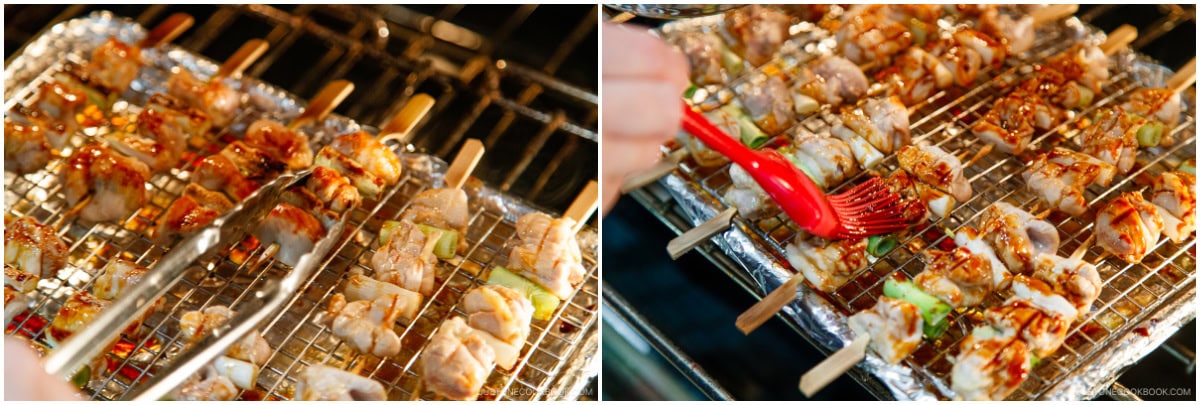
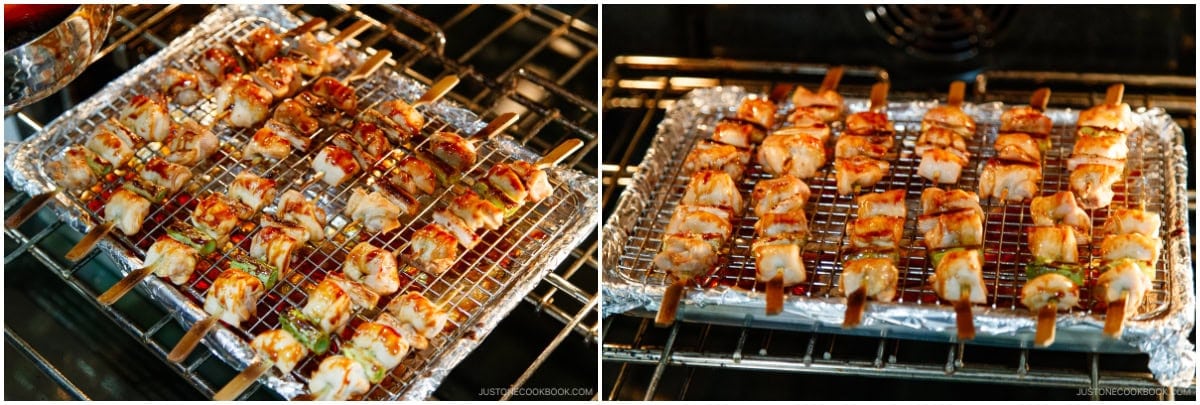
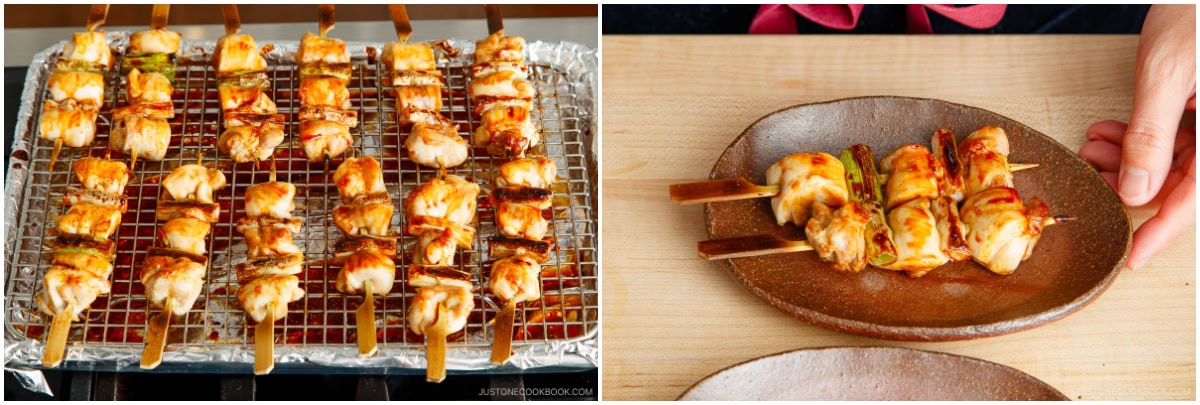











The yakitori was delicious!! Thank you so much!! I’m hoping you’ll post some hints for putting chicken livers on skewers so that they stay on and cook nicely. I’ve tried many times, but no luck.
Hello, Connie. Thank you so much for taking the time to read Nami’s post!
A common technique for chicken livers is to insert the skewers in a zigzag pattern so that the livers stay on the skewers.
Another option is to use wider and flatter bamboo skewers.
We hope this helps! 😃
I’m curious about the sodium in the nutrition information (I’m on low sodium). 234 mg. is fine, but 1/2 cup of soy sauce by itself is 6700 mg.; almost three times that level of sodium per skewer. Does most of the sauce drip off while broiling? Or don’t you use the whole sauce recipe?
Thanks
Hello Jack! Thank you for giving Nami’s recipe a try.
The recipe includes extra sauce, and it is not necessary to use all of it. Additionally, while brushing and broiling, most of the sauce tends to drip off.
Our goal is to provide realistic data, but please note that the nutrition information is only an approximation. Please use it as a guide since cooking styles may vary depending on a person’s preference.
We hope this helps!
Very tasty I find the sauce does not thickens as much as I tried to reduce it. It’s still very runny. I did marinade my meat first before grilling them. Brushing it with the Yakitori sauce every so often. It turned out to be juicy and tasty. Thank u!
Hi Amy! Thank you so much for trying Nami’s recipe and sharing your Yakitori photo with us. It looks delicious!
If you like a thicker sauce, such as Teriyaki, a little sugar can be added to thicken the sauce. However, because of the sugar, it will easily burn. Yakitori sauce is typically runnier in consistency.
We hope this helps!
Great recipe, the yakitori tastes great! Only two issues.
1. I left the yakitori sauce on my stove for over an hour to reduce it and left it out to cool afterwards, but it didn’t get any thicker. Any idea what the issues might be?
2. A lot of yakitori sauce drips onto the foil i put underneath (probably because it’s so soupy) and caramelizes and then burns. Really stinky. How do you avoid this?
Thanks!
Hello, Lukas! Thank you for attempting Nami’s recipe!
Yakitori sauce does not thicken as much as Teriyaki sauce since it has less sugar. You can add additional sugar if you like.
Instead of brushing a large amount of sauce on at once, brush the sauce over the Yakitori meat a few times throughout cooking to add flavor. This will help to decrease dripping.🙂
We hope this helps!
Not sure what I did wrong in making this. I cut the chicken to the right size and put it under the broiler at 500, but even after 20+ minutes, the chicken wasn’t cooked. I don’t know if I needed to put it closer to the broiler, but my fiancee had to turn on the grill and finish it off for us. Usually don’t have issues with Nami’s recipes, so I feel like it’s user error on my part.
Hello, Ashley! Thank you for attempting Nami’s recipe!
Your chicken seemed too far away from the broiler heat element. Yes. Please bring them closer next time. It is usually best to keep around 8 inches (20 cm) away from the top heating element (in the middle of the oven).
We hope this was helpful!
Thanks, Naomi! I definitely think it was a little too far away from the broiler. For what it’s worth, the yakitori was delicious when we finished it on the grill!
I grilled it instead 😋 Great recipe! I’m looking forward to making a big batch and sharing this good food with friends and family.
Hi KayCee! Wow! 🤩 Thank you very much for trying Nami’s recipe and sharing the photo with us! It looks so delicious!!!
Fabulous recipe, thanks Nami. Substitute the scallion with king oyster and yellow pepper. The missus love them!
Hi Lionel! Fabulous!🤩 Thank you very much for trying Nami’s recipe and sharing your photo.
Happy Cooking!
Dear Nami, I grilled these yakitori outside for my summer bbq party with friends and it was a hit 🙂 Thank you!
Hi Addie! Thank you for trying Nami’s recipe!
Nami and JOC team are so happy to hear you and your friends enjoyed Yakitori!
Happy Summer!
Thank you very much for the recipe, Namiko . It was another hit with the fambam.
Hi Catherine-Ann! Great photo!🤩 Thank you very much for trying Nami’s recipe and for your kind feedback!
The skin is the best part IMO.
Hi Nathan!😁 We are glad to hear you enjoyed Yakitori!
I’ve seen other recipes that call for marinating the chicken in the tare sauce. How come you do not marinate the chicken in your recipe?
Hi Christina, Thank you very much for reading Nami’s post and trying her recipe!
In Japan, we usually do not marinate Yakitori meat, instead enjoy the simple meat flavor with coated Yakitori sauce on the outside.
If you prefer more sauce flavor in the meat, you can marinate them for about 20 minutes.
We hope this helps! 🙂
I want to make this again (so delicious) but serve as a main dish. What do you recommend I serve this with? I considered Onigiri and a salad or vegetable but would like your suggestions before I decide!
Hi Susan! Thank you very much for trying Nami’s recipe and for your kind feedback!
Onigiri or Yaki Onigiri and Salad sound great!!!
You can also add simple miso soup if you like.
Please check out the “MAKE IT INTO A MEAL” recipes at end of this post for reference. (below this recipe post)
We hope this helps!
One time I went to an incredible yakitori restaurant in Japan. The chef had a metal shaker and shook seasoning over all the skewers and veggies before grilling. The veggies were the best I have ever tasted. Do you have any idea what the seasoning powder was? I don’t remember a distinct flavor other than salty and savory. Do you think it was MSG or some kind of salt/spice blend?
Hi Kat! Thank you very much for reading Nami’s post!
Each Yakitori restaurant has a secret seasoning. So we are not sure what was exactly inside the shaker. But we guess that it’s a mix of white pepper, salt, and spices.
We hope this helps!
Good chance there might have been some Sansho Pepper in there.
Shichimi Togarashi is a shaker spice that is really cool. No, it is hot. But mildy so. Possibly a starting point. Good stuff.
Really good recipe. I made it tonight. Both my Japanese wife and I liked it. Living in an apartment, we were not able to barbecue outside and I don’t like to broil or cook meats at high temperatures, so we baked the yakitori in the oven. I cooked them at 375 deg F for about 15 minutes, flipped and cooked for about ten more minutes. Put the yakitori sauce on and baked for about 5 more minutes on each side. Turned out really delicious.
I had some drumsticks and cut the chicken off the bone and used it for this recipe. Worked really well. I also cut up some red peppers and added them.
For those making it for the first time, a little sauce goes a long way. The sauce is so good, it is tempting to put a lot on. Don’t do that. Just a little is enough for our tastes.
Sauce was very good. My wife found the sauce a little salty for her taste. Maybe I boiled it down a little too much. Next time I might cut down on the soy sauce a little and add a little more sugar.
Thanks again. My favorite recipe site.
Hi Jim and Yuka! Thank you very much for trying Nami’s recipe and for sharing your cooking experience and tips!
We are so happy to hear you enjoyed Yakitori! Happy Cooking!
I just made this today on the grill outside with my husband and it was so delicious. Thank you so much for your recipes. My husband, 1-year-old baby, and I devoured every last bite.
Hi Rebecca! We are so happy to hear your family enjoyed Yakitori!
Thank you very much for trying Nami’s recipe and for your kind feedback!